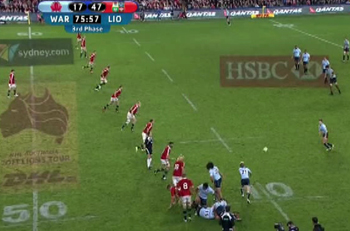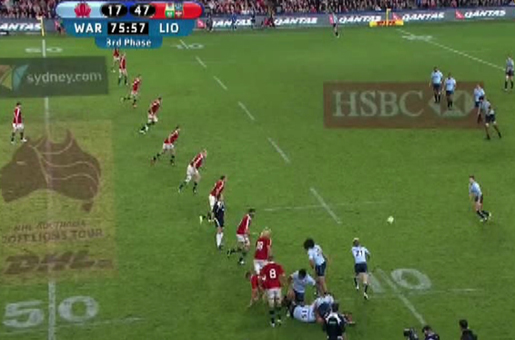
As you can see from the image to the right the Lions defensive structure presents a wall of red – one straight line moving forward with really good line speed.
I know people were complaining that the Lions defence was continually offside against the Waratahs on Saturday – I also heard lot’s of complaints that Jonathon Davies must have been offside when he took that intercept, which the replay clearly showed he wasn’t. Similarly if you look at the replay of that match in detail you’ll find that of 71 Waratahs breakdowns the Lions only got in front of the last feet on 3 occasions – the appearance of the Lions being offside simply comes from great line speed.
So, with a wall of red getting up in their faces where is the space for the Wallabies to attack and what’s creating that space?
I’ll answer the second part of that question first. The Lions are using the English defensive system, which is no surprise given the English defence coach, Andy Farrell, is also the Lions defence coach. That system relies on both the blind side and open side wingers starting up in the line, whereas most teams start the open side winger positioned a little behind the line giving them the flexibility to move up into the line or to stay back to help cover a kick.
With the open side winger starting up in the line there is space in behind that winger which the fullback is required to move across and cover.
This creates three spaces that the Wallabies can attack:
- If the fullback does get across far enough to cover the space in behind the winger that often leaves space in mid-field in behind the line – the chip kick is then the option as we saw the Wallabies do so well against England on the end of year tour in 2012;
- With the open side winger starting up in the line this often creates a narrow defensive line and leaves space outside the winger as we saw aginst both the Reds and the Waratahs – to take advantage of that space you need someone with a good, long pass. We saw Quade Cooper find that space and we also saw Bernard Foley finding the same space. Do the Wallabies have anyone in their squad who can get the ball to that space? James O’Connor can as can Christian Lealiifano whereas Kurtley Beale and Berrick Barnes are more limited with their long passing game. Regardless of capability, will the Wallabies seek to target that wide space when running the ball? Unfortunately I don’t think they will;
- With both wingers starting up in the line the fullback has a lot of space to cover in the back field – sometimes the flyhalf gets back to help but the Lions offer a lot of space in the back field to target.
Whilst taking advantage of two of the three spaces requires a kicking game, which isn’t a popular option with most fans, kicking doesn’t have to be a defensive tactic just seeking to play field position. It can be an attacking option where you seek to recover the ball.
The chip kick in behind the line is one option that can be used with the aim of recovering the ball, not kicking possession away. Once the Lions move to cover that option with their fullback holding closer to mid-field the Wallabies will have the opportunity to put a cross field kick in behind the open side winger for Israel Folau to soar high and score.
Long kicks to the corners don’t have to just be about gaining territory. Aim to keep the ball in play and rely on your back three winning the chase against the Lions back three who will be at a disadvantage having to turn and chase.
Watch the video to see some examples of the three spaces I’ve talked about, to see how the Lions defensive system opens up these spaces and how the pendulum defensive system that other team use works to reduce these spaces.
Keep an eye out in the Brumbies match against the Lions tonight to see if these spaces are apparent.


